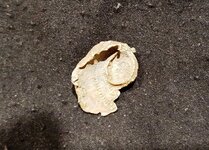- Mar 5, 2010
- 7,600
- 12,171
- Detector(s) used
- XP Deus, White's DFX
- Primary Interest:
- All Treasure Hunting
I know it's not much to go on but here goes. I found this bullet today at the Spanish-American war camp site we have been hunting. The only measurements I can give you are the weight and approximate diameter of the base. It weighs 185.6 grains and the base measures anywhere from .36 to .44". There are two cannelures, one is just above the base and is all but gone. The other is visible about 1/4" above the base. I know it is post 1870 by the ridges in the cannelure but that is all.








